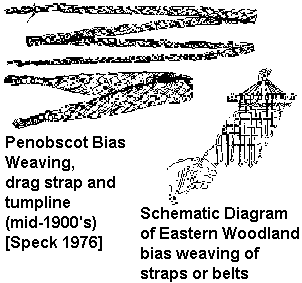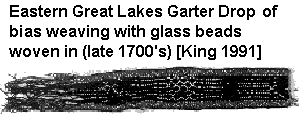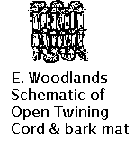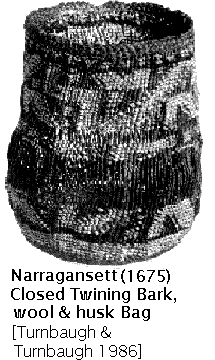NativeTech: Native American Technology and Art
NATIVE AMERICAN BEADWORK
Bead Weaving Techniques and Analysis
Beads are perhaps one of the earliest
forms of Native American art. Beads are by their nature, intended
to be strung on cord and various techniques have developed and
evolved over the millennia in the eastern Woodlands. Some methods
of stringing beads are similar to those used in textile and basket
weaving. Beadweaving shares many technical traits with woven mats
and twined baskets, and it may have developed alongside these
other industries.
Woven Beadwork consists of two
things: beads and string. The string used can range from animal
proteins such as twisted sinew or hide thong to twisted cord from
numerous plants, bark and roots. Twisted cordage needed to be
made from otherwise short fibers for beadweaving, as it requires
a string long enough to go through a great length of beads. Dogbane
stalks, basswood bark and cedar bark or roots are commonly made
into cord for beadweaving. Though European threads were available
during early contact, Natives continued to use their own cordage,
which was also deemed of superior quality by Europeans.
![double strand warpless [wire-weave]](img00001.gif)
| In weaving, as opposed to knotting
or looping strings around each other, the bead represents an
alternate way to secure strings together. Without the beads, loomwork
would fall apart! The earliest forms of weaving by Natives of
North America were probably hand-held 'finger-woven' techniques,
developed from simple forms of braiding in which one end of a
length of strings is anchored. The free end of the lengths are
held in the hands and interwoven by taking the elements from the
outer edges and bringing them to the center. There is no separate
warp or weft with hand-held methods of 'finger-weaving', as the
outer warps are each in turn then used as wefts as the work progresses.
|

| The simplest and perhaps the earliest
form of beadweaving is hand-held, using techniques similar to
braiding. This technique is often refered to as 'wire-work'.
Ironically, though 'wire-work' is perhaps the first type of woven
beadwork, the term comes from a 20th century type of
beadwork using glass seed beads on thin wire to make rings and
other commercial jewelry.
|

| Building on the same principles
in 'wire-work', bias-weaving was used to produce many wampum collars
in the Northeast during the 17th and 18th
centuries. Bias-weaving beadwork techniques are nearly identical
to those used for Native-made textiles such as basswood burden
straps and yarn belts and garters in 17th century New
England.
|

|
When archaeologists or ethnotechnologists are analyzing
fragments of very old beadwork, they must be very careful to observe
the selvedges of woven fragments. Being unaware of 'false fringe' effects produced
by broken warps and missing rows of beadwork can lead to erroneous
interpretations of beadwork techniques.
|

| European contact introduced metal
tools, enabling the Native production of smaller shell beads,
and also made available a flood of glass trade beads and iron
needles. Native Americans developed ways to weave larger pieces
of beadwork using smaller tools and supplies. It is more practical
to anchor both ends of the long strings, the warp, and to use
a separate element, a weft, to secure on the beads. Separating
the strings in two weaving elements, warp and weft, required the
use of a loom. The bow loom is the most elemental form of free-standing
loom (meaning no part of the work is attached to the weaver).
|

| Using a bow loom, beads can be
individually strung on a doubled weft, which is parted and passed
around each warp string, paired again and passed through a bead,
and so on. This technique is called 'double-strand square-weave'.
The weave is 'square' because it progresses across each row to
the next column, in a square direction.
|


|
The technique has parallels
with Native American twined mats and baskets. The weft makes
a pattern of X's on the outer warps of the beadwork, showing how
each weft crosses it mate as it moves to string on the next row
of beads.
|

| It is possible, though not time-effective to do double-strand
square-weave without the use of a loom, by anchoring one end of
the beadwork as in bias-weaving. Double-strand square-weave does
not absolutely require the use of a needle, as the beads for each
row can be placed on the doubled thread on at a time.
|

| Because
of the similarities of double-strand square-weave to bias-weaving,
and because it doesn't require a needle, it was probably the first
technique of loomed beadwork used by Natives of the Eastern Forests
for the large wampum belts in the 1600's.
|

| Another beadwork technique for
the loom, commonly used today by many Native Americans, is 'single-strand
square weave'. With this technique, a single weft is used that
passes through the same row of beads twice, before progressing
to the next row. Because weft cannot secure the beads on either side of the warp one at
a time, a needle must be used to get the weft through back through
the entire row of beads. This method of beadwork has obviously
been used for a long time, as wampum belts from the 1600's through
the 1800's also use the 'single-strand square-weave' technique.
|

| For each of the basic hand-held
and loomwork methods, there are innumerable variations. An infinite
number of effects can be achieved by wrapping or varying the number
of warps, or by changing the way the weft goes around the warp.
On a very local level, as the degree an intensity of European
contact varied from area to area, there appears to be a chronological
sequence from hand-woven multi-strand beadwork to needle-loomed single-strand beadwork,
coming full circle back to a revival of hand-woven 'wire work' in this century.
|
Index to Techniques of Woven Beadwork using Diagrams
Return to NativeTech's Beadwork Menu
Beadwork Bibliography and Books to Buy On-Line
|

|
Text and Graphics
© 1994 -
Tara Prindle
unless otherwise cited.
|
![double strand warpless [wire-weave]](img00001.gif)
![double strand warpless [wire-weave]](img00001.gif)











